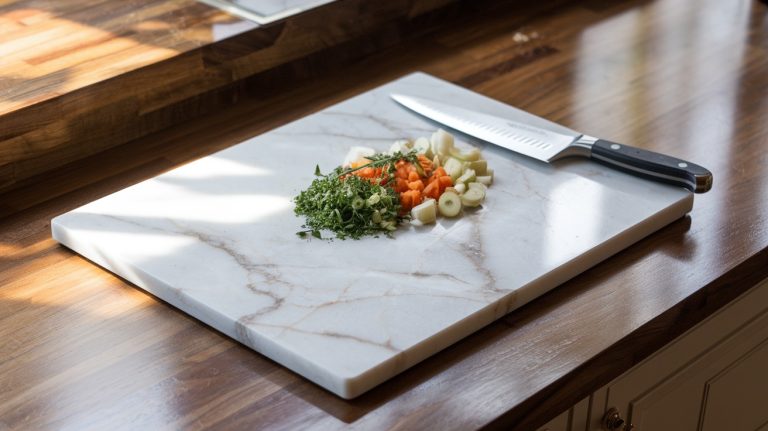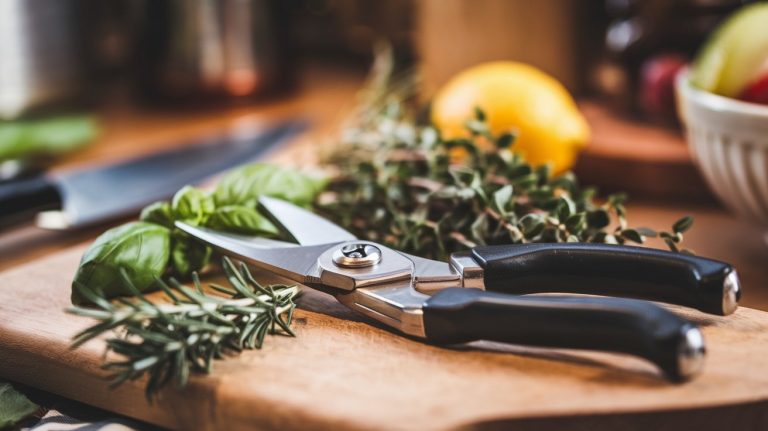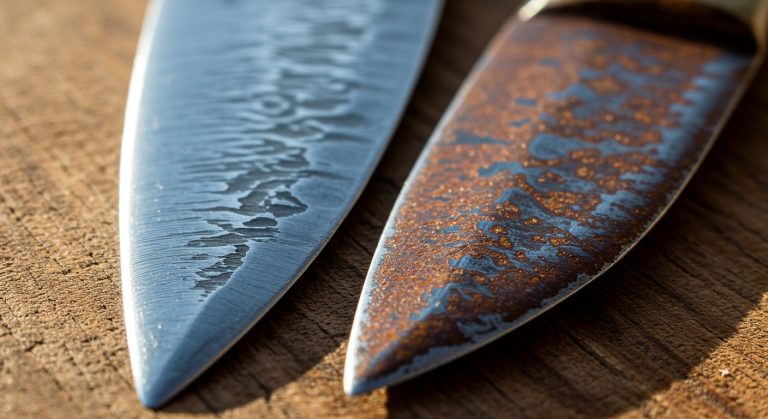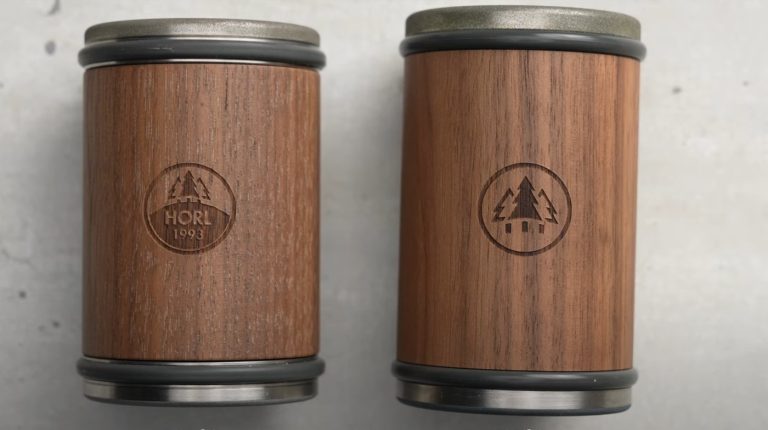How to Use a Knife Sharpener Rod: A Simple Guide
To use a knife sharpener rod, hold the rod vertically against a stable surface. Position the knife at a 15-20 degree angle, depending on the blade type.
Starting at the heel, swipe the knife in smooth strokes towards the tip, alternating sides after 5-6 strokes. Apply light pressure and maintain a consistent angle for best results.
Regular honing keeps your knife sharp and ready. Stick around to discover more tips for effective knife maintenance and honing techniques.
Key Takeaways
- Position the honing rod vertically on a stable surface, bracing it against your body for added support while honing.
- Maintain a consistent angle of 15-20 degrees during honing; use 15° for Japanese knives and 20° for Western knives.
- Use smooth, alternating strokes from heel to tip, typically performing 5-6 strokes on each side of the blade.
- Apply light pressure while honing to avoid slips, and focus on maintaining the knife’s edge retention.
- Regularly clean the honing rod and inspect it for wear or damage to ensure effective honing performance.
Different Types of Honing Rods
When it comes to maintaining your knives, understanding the different types of honing rods is crucial. You’ll find honing rods made from stainless steel, ceramic, and diamond-coated materials.
Stainless steel is great for softer steels, while ceramic, being four times harder, suits harder blades like Japanese knives. If you need something more abrasive, diamond-coated rods can quickly sharpen dull knives but may remove too much metal if misused.
Stainless steel rods have been noted to show the highest efficiency in improving sharpness by over 60% or more. Additionally, pull-through sharpeners tend to remove excessive metal, which can compromise the knife’s longevity and performance.
Each rod has unique design features; for example, stainless steel rods often have longitudinal ridges for better control. When choosing a honing rod, consider the hardness of your knife, its length, and your budget to guarantee effective maintenance.
The Difference Between Honing and Sharpening
Although honing and sharpening are often used interchangeably, they serve distinct purposes in knife maintenance. Honing realigns the existing edge of your knife, while sharpening removes metal to create a new edge. To help you understand, here’s a quick comparison:
| Aspect | Honing | Sharpening |
|---|---|---|
| Purpose | Realigns the edge | Creates a new edge |
| Tools Used | Honing rod | Whetstones or electric sharpeners |
| Frequency | Daily for heavy use | Every 6-12 months |
Essential Techniques for Proper Honing
To hone your knife effectively, start by positioning the honing rod vertically on a stable surface for ideal control. While honing, use smooth strokes from the heel to the tip of the blade, maintaining a consistent angle between 15 and 20 degrees.
This technique guarantees your knife edge stays sharp and aligned. Regularly using the honing rod helps maintain knife edge precision and durability over time, which is essential for regular honing to prevent dulling.
Rod Positioning Tips
Proper rod positioning is essential for effective honing, and there are several key techniques to guarantee stability and control. Start by placing the rod vertically on a non-slip surface, like a cutting board, to make certain it doesn’t move.
Make sure the tip of the rod is firmly planted, providing you with a stable base. Here’s a quick reference table for ideal positioning strategies:
| Technique | Description | Benefits |
|---|---|---|
| Counter or Board | Place on the edge for easy access | Stability & control |
| Non-Slip Surface | Use a mat or cloth underneath | Prevents sliding |
| Body-Braced Method | Brace against your body for extra support | Enhanced stability |
| Comfortable Height | Adjust rod height for ease of use | Smooth strokes |
For optimal results, ensure that the rod is suitable for the type of knife you’re honing, as different rods serve various knife maintenance needs.
Stroke Techniques Explained
Once you’ve positioned the honing rod correctly, mastering stroke techniques is the next step to achieve a razor-sharp edge. Here are some essential techniques to keep in mind:
- Freehand Method: Hold the rod in your non-dominant hand, sweeping the knife from tip to handle.
- Body-Braced Method: Brace the rod against your body for added stability and control. This technique can greatly enhance ergonomic handling and reduce the risk of slips.
- Angle Control: Maintain the correct angle—15° for Japanese knives and 20° for Western knives. Honing rods are designed to maintain the edge of already sharp knives, ensuring they remain effective with regular use.
- Alternating Strokes: Alternate sides to balance the blade and prevent uneven wear.
Advanced Honing Techniques and Safety Tips
When honing your knife freehand, focus on maintaining a consistent angle to achieve the best results. A consistent sharpening angle is essential for achieving an evenly sharp edge. Remember to prioritize safety by securing your setup and gripping the knife firmly to maintain control.
Regularly clean your rod and store it safely to prevent any accidents or damage. Additionally, ensure you understand the impact of steel composition on your knife’s edge stability, as this knowledge can guide you in choosing the right honing technique.
Freehand Honing Method
While honing your knife freehand can seem intimidating, mastering this technique opens up a world of precision and efficiency in maintaining your blade’s sharpness.
Here are some key points to remember:
- Angle Control: Keep a consistent angle between 15 to 20 degrees for effective honing.
- Rod Selection: Choose between ceramic, steel, or diamond rods based on your knife’s material. Stainless steel knives, for example, benefit from their corrosion resistance due to chromium content.
- Honing Motion: Start at the blade’s base, swiping down the rod with light pressure, alternating sides. Freehand honing allows for quick transitions between tools and grits, making it an efficient method for maintaining sharpness.
- Assessing Sharpness: Test your knife by slicing through paper; a clean cut means you’ve successfully honed it.
Safety Precautions
To guarantee a safe honing experience, it’s vital to follow proper safety precautions and techniques.
Start by wearing cut-resistant gloves and safety goggles to protect yourself from injuries. Ascertain your sharpener or rod is on a stable, non-slip surface to prevent accidents.
Understanding different sharpening methods can significantly enhance your knife performance, as proper maintenance ensures optimal functionality.
Maintain a consistent angle, ideally between 15 and 20 degrees, while honing, applying light pressure to avoid slips. Always inspect your knife for nicks or damage before sharpening.
If you’re using power tools, follow the manufacturer’s instructions and keep your workspace clear of distractions. Remember to cut away from your body and maintain proper posture to stay focused.
Matching Knives With the Right Rod
When matching your knives with the appropriate rod, consider the following:
- Ceramic rods work best for ceramic knives, providing gentle honing. Regular use of ceramic rods can help maintain the blade’s sharpness for longer periods.
- Steel rods are ideal for stainless steel knives, realigning edges without removing material. It’s important to use a steel rod with the right angle to ensure the best results.
- Diamond rods are perfect for harder steel knives, allowing for quick sharpening. These rods can effectively remove any burr formed during previous sharpening sessions.
- Serrated knives need specialized rods or techniques for proper maintenance. Additionally, using a honing rod regularly can prolong knife life by preventing misalignment and dullness. Proper maintenance, including regular honing, can significantly enhance the knife’s performance over time.
Best Practices for Rod Maintenance and Use
Maintaining your knife sharpener rod is essential for ensuring its effectiveness and longevity. Clean the rod regularly with Bar Keepers Friend and water to remove metal particles.
Using the right tools for sharpening serrated knives prevents damage to serrated edges, which is crucial when maintaining your overall knife collection. Regular sharpening helps enhance the performance of your blades, ensuring they stay in peak condition.
Store it in a dry place to prevent rust and corrosion. Handle the rod carefully to avoid drops that could cause damage. Frequently inspect it for signs of wear or damage, and replace it if it becomes ineffective.
When using the rod, maintain a consistent angle and apply light to moderate pressure based on your knife’s condition. Use strokes from the heel to the tip of the knife, and aim to sharpen your knives weekly.
Frequently Asked Questions
How Do I Know When to Hone My Knife?
You’ll know it’s time to hone your knife when it struggles to cut smoothly or feels dull during use.
Regularly inspect the blade for any visible bends or misalignments. If you use your knife frequently, honing after each use can help maintain its edge.
Additionally, if you notice the knife snagging on harder surfaces, it’s a sign that honing is needed to realign those micro-serrations effectively.
Can I Use a Honing Rod for Serrated Knives?
You can’t use a standard honing rod for serrated knives.
Their unique edge structure requires specialized honing rods designed specifically for serrated blades. Using a regular rod risks damaging the serrations and won’t effectively realign the edge.
Instead, look for tools or techniques tailored for serrated knives to maintain their sharpness.
Regular maintenance is essential, but it’s a bit trickier than with straight-edged knives, so choose wisely!
What Maintenance Is Required for Honing Rods?
You might think honing rods don’t need much attention, but regular maintenance is crucial for peak performance.
Start by cleaning your rod before and after use to prevent metal buildup. Inspect it visually for wear or dirt.
Store it in a dry place to avoid rust. Depending on the material, use appropriate cleaning methods—like Bar Keepers Friend for ceramic rods.
Is There a Specific Order for Honing Different Knives?
Yes, there’s a specific order for honing your knives.
Start with the ones you use most frequently, ensuring they maintain their sharpness.
Follow with those used less often, like specialty knives.
If you have both Western and Japanese knives, hone the Japanese ones first due to their sharper angles.
Always be mindful of each knife’s unique sharpening angle to avoid damaging the edge.
Regular honing keeps your knives in top condition!
How Long Does a Honing Rod Typically Last?
Think of a honing rod as a trusty old friend, lasting around 2 to 3 years if you treat it right.
Regular cleaning with a damp cloth or a specific eraser keeps it effective, much like nurturing a relationship.
If you use it frequently, its lifespan can shorten, so don’t neglect maintenance.
Quality matters too; a high-quality rod will stick around longer than a cheaper one.
Keep it clean, and it’ll serve you well!
Keep Your Blades Sharp & Your Cuts Precise
By mastering the use of a honing rod, you can extend the life of your knives considerably. In fact, studies show that regularly honing your knife can keep it sharp up to 40% longer between sharpenings.
Remember, honing isn’t just about maintaining sharpness; it’s also about safety and precision in your cuts.
So, make it a habit to incorporate honing into your kitchen routine, and enjoy the benefits of well-maintained, efficient knives.







